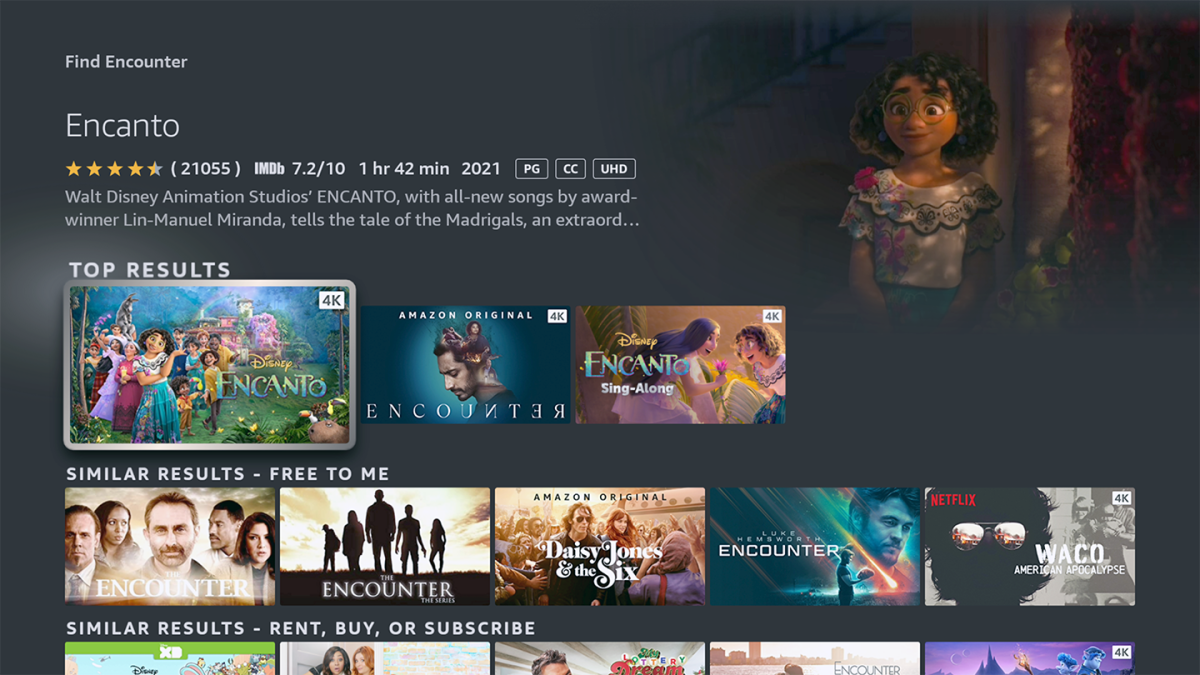Put your hand up if you enjoy using your TV remote to type in the name of the show you want to watch next. Who doesn’t love shuffling the highlighted box across the screen, painstakingly selecting each letter in turn? And let’s not forget the joy of accidentally selecting a wrong letter.
Such text-based search works, but it can feel like a chore. It’s much easier and faster to just ask for what you want. With Amazon’s Fire TV, you can ask the Alexa voice assistant to find your favorite shows, movies, movie genres, actors … you name it.
But voice-based search can come with its own frustrations. What if Alexa misheard a request for the TV show Hunted as “haunted” and as a result presented a spooky screenful of incorrect suggestions?
This is a story of how two groups at Amazon — the Fire TV Search team and the Alexa Entertainment Spoken Language Understanding team — collaborated to launch an improved Fire TV voice search experience in the U.S. in November 2022.
The new search system gives customers a greater chance of finding what they are looking for, on their first attempt, by casting the search net a little wider — and a little smarter. It works by harnessing a suite of Alexa machine learning (ML) models to generate additional, similar-sounding words to inject into Fire TV’s search function to broaden the scope of the results presented to the customer. Hence its name: phonetically blended results (PBR). Today, about 80% of the 20 million or so unique search terms that Fire TV deals with are augmented by PBR.
To better understand PBR and why it was needed, let’s look at one reason the previous version of Fire TV voice search could get things wrong. A customer, in a noisy room full of excited children, holds down the microphone button on the Alexa Voice Remote and simply says “Find Encanto”.

This piece of audio first goes to Alexa’s automatic-speech-recognition (ASR) system to be converted to text. But in this case, the system mishears the customer utterance and converts it to “Find Encounter”.
Fire TV’s search algorithm, known as ReRanker, faithfully performs the erroneous search and presents the customer with a selection of content with the word “encounter” in the title or description, prominently featuring, for example the Amazon original movie Encounter or popular TV shows that include that word. Encanto is nowhere to be seen. The customer sighs, asks the kids to pipe down, presses the microphone button and tries again. Or they resort to the very method they were trying to avoid in the first place: typing with the remote.
One challenge here is that because Alexa supports myriad applications, its ASR system is necessarily generalized.
“Previously, Alexa was not tuned into individual Fire TV customers’ preferences,” says Kanna Shimizu, senior manager of research science in Alexa AI’s Natural Understanding (NU) group, who led the PBR project. “That's the layer my team is adding. We are connecting Alexa machine learning with Fire TV search algorithms to build toward an end-to-end algorithm to help customers find what they’re looking for.”
The reason the voice search for Encanto failed is that the search process decided early on that “encounter” was the customer’s intended search query, so “Encanto” wasn’t even searched for.
“The big change that PBR introduced was to say, ‘Actually, the customer might have said or meant this other thing, but we’re not sure, so let’s search for both,’” says Shimizu. “Let’s keep the door open to different interpretations of what the customer may have said, so they can decide for themselves on the search results screen.”
How would our customer example look now? The search results page will now show Encanto as an option in addition to Encounter.
Building this keep-your-options-open approach into Fire TV voice search was complex for several reasons. One challenge is generating appropriate additional search candidates that are phonetically similar to the customer’s utterance. The next was changing Fire TV’s ReRanker algorithm, already a high-performing recommender system, to utilize the PBR system’s suggested search candidates when delivering results to the customer.
It's really a two-way communication. We use Alexa models to improve the performance of Fire TV and we use Fire TV customer signals to improve the performance of Alexa models. It’s a very cool learning loop.
The PBR system addresses the first challenge in multiple ways. Most of the additional search candidates come from corrective actions taken by customers themselves. That’s because when a customer’s voice search fails to deliver what they are looking for, about 40% of the time they will try voice search again or type what they are looking for, leading to a successful viewing. Knowing the initial mistaken search term and the final successful one allows the PBR system to, for example, map the search candidate “Encounter” onto the additional search candidate “Encanto”.
That self-correction process is how PBR learned that the search term “hunted” sometimes represents a search for the 2018 Netflix reality series Haunted.
The PBR system can make these useful connections in part because it contains knowledge of the wider world via the Alexa Teacher Model, a large language model trained on enormous amounts of Internet data and subsequently fine-tuned with data including Fire TV voice traffic and customer self-corrections.
“It's really a two-way communication,” says Mingxian Wang, senior applied scientist at Alexa AI-NU. “We use Alexa models to improve the performance of Fire TV and we use Fire TV customer signals to improve the performance of Alexa models. It’s a very cool learning loop.”
Besides the Alexa Teacher Model and the model that learns from customers’ on-screen search behavior, the PBR system also uses an Alexa model that identifies phonetic variations for popular titles, to further enrich its search results.
Using a mixture of these three models, by the time it launched in late 2022, the PBR system had already generated millions of search-query mappings, such as “Encounter” to “Encanto” — and that number continues to grow. Here’s another example. To avoid Alexa mishearing “Zatima”, a popular new show and a novel word unknown to ASR, as “Fatima”, which is a movie and also a city in Portugal, PBR’s models suggests that Zatima also be presented along with Fatima.
“In this way, we serve the customer who wanted the new show and also don’t break the customer experience for those searching for the movie,” says Wang.
“It’s a subtle balance”
It's one thing to suggest additional results to ReRanker. It’s another to change the algorithm to take PBR’s suggestions and present these results to customers. And if it does, how should it rank them on the results screen?
The teams solved this problem by inventing the PBR confidence score. With every search-query mapping, the PBR system provides ReRanker with a prediction of how likely the customer is to click on that result.
“We want customers to see our alternatives but don’t want to boost them higher than might be warranted, because we want to avoid overwhelming customers with irrelevant search results,” says Shimizu. “It’s a subtle balance, and that scoring mechanism was the key to making this whole thing succeed.”
To illustrate this subtlety, consider the search term “Enchanted” (a fairy-tale movie). The PBR system estimates that search results based on this term will deliver a customer clickthrough rate (i.e., a successful search) of 60%. So this should be the most prominently displayed result.
But the search term “enchanted” also triggers several PBR candidates — “Encanto” (with an anticipated clickthrough rate of 20%) and “Disenchanted” (5%). You can see that by blending these similar-sounding shows into its results, ReRanker is more likely to strike gold for the customer.
“In testing, we saw the ReRanker model picking up on the PBR confidence score and boosting those search results higher. It learned that this feature was worth paying attention to,” says Aleksandr Kulikov, a principal software engineer at Fire TV.
“The Fire TV voice search is already successful for most customer voice searches — it’s easy to deliver popular searches like ‘Jack Ryan’ correctly — but for some customers, PBR is significantly improving their voice search experience,” says Kulikov. Where it makes the biggest difference is, of course, in ambiguous searches, where it can boost customer clickthroughs by 10% or more. “A gain of 10% is like, wow, that’s significant,” Kulikov adds.
And it will only get better with time. The Alexa and Fire TV teams are working toward a feedback learning system that will allow PBR’s models to automatically generate new search candidates, prune ineffective ones, and home in on increasingly accurate confidence scores.
Ultimately, bringing the power of multiple Alexa machine learning models to bear on Fire TV voice search is helping to give Amazon customers what they want the first time, more of the time, through a greater understanding of diverse voices and of the world itself. Hands up if you like the sound of that.





















